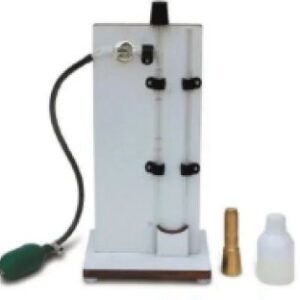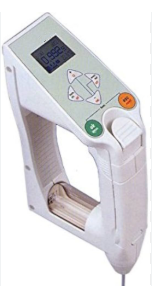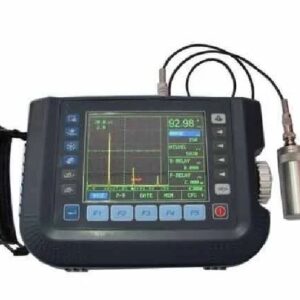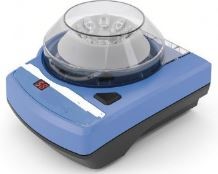REFRIGERATED MICRO-CENTRIFUGE
MAKE DINESH SCIENTIFIC
DESCRIPTION
With the use of centrifugal force, materials with varying densities can be separated in a sophisticated laboratory device called a chilled centrifuge. It works on the idea that the denser particles in a sample travel outward and form different layers when it is spun rapidly. The following is a thorough explanation of a chilled centrifuge:
A sophisticated laboratory tool called a chilled centrifuge is used to separate particles according to their density from a liquid mixture. Centrifugal force is utilized by this apparatus to quickly spin samples in a temperature-controlled setting, usually between sub-ambient and room temperature.
FEATURES :
- Benchtop Refrigerated Centrifuge:
- Robust C.R.C. structure with powder-coated finish
- A centrifugal bowl made of stainless steel for added protection and simple cleaning.
- Equipped with an electronic drive and a well balanced brushless motor.
- There is an automated dynamic brake and an imbalance detector.
MAIN COMPONENTS:
- ROTOR: The sample tubes or containers are held in place by the centrifuge’s rotor. It creates centrifugal force by spinning quickly.
- MOTOR: The rotor is driven by a strong motor, which enables high rotation rates
- CONTROL PANEL: Users can adjust centrifuge process parameters like speed, temperature, and duration via the control panel.
REFRIGERATION SYSTEM:
- This feature separates a conventional centrifuge from a chilled one. It has a cooling system that keeps the centrifugation temperature low, which is essential for protecting the integrity of samples that are sensitive to temperature changes.
FUNCTIONALITY:
- CENTRIFUGATION: The main purpose is to rotate the samples quickly such that the denser components settle to the bottom of the tubes.
- REFRIGERATION: The centrifuge’s internal temperature is regulated by an integrated refrigeration system, which permits sample separation without jeopardizing the integrity of materials that are sensitive to temperature changes.
APPLICATIONS:
- CELL SEPARATION: Cells are divided according to density in biological research.
- PROTEIN PURIFICATION: vital for separating and purifying proteins from complicated mixtures in biological investigations.
- DNA AND RNA EXTRACTION: helps to separate nucleic acids from biological materials more easily.
- CLINICAL DIAGNOSTICS: utilized in clinical labs for a range of diagnostic procedures, including the separation of blood components.
TEMPERATURE CONTROL:
- Depending on the model, the refrigeration system can normally regulate the temperature between below ambient and below zero.
SAFETY FEATURES:
- LID LOCKING MECHANISM: Makes sure the centrifuge lid stays firmly closed while it is in use..
- AUTOMATIC IMBALANCE DETECTION: In the event of an imbalance, stops the centrifuge to protect the samples and the device.
CAPACITY AND SPEED:
- SAMPLE CAPACITY: To handle a variety of sample sizes and kinds, refrigerated centrifuges are available in a range of sizes and rotor designs.
- SPEED CONTROL: Users can adjust the centrifugation settings for various applications using variable speed control.
USER INTERFACE:
- Digital Display: For convenient monitoring of the settings, remaining time, and speed, the control panel usually has a digital display. In conclusion, a refrigerated centrifuge is a multipurpose laboratory instrument that combines temperature control and centrifugation principles, allowing scientists to precisely separate and analyze samples, particularly when working with materials that are sensitive to temperature.
TECHNICAL DETAILS:
| MODEL | DS-RC-AR |
| Type | Benchtop multifunctional chilled centrifuge with refrigeration |
| Interface | Touch screen |
| Motor Driver | Robust motor driver powering a variety of high speeds |
| Drive Type | Brushless induction drive that needs little upkeep |
| Rotor Compatibility | Capable of accommodating both fixed-angle and swing-out rotors |
| Tube Compatibility | There is an adapter to use different tube formats. |
| Temperature Range | -9°C to 40°C |
| Rotor Material | · Chemical-resistant, completely autoclavable at 121°C
· Metallic rotors and rotor covers |
| Display | · Splash-proof LCD display with all rotor parameters displayed
· User-friendly operation |
| Control Panel | Touch screen panel with configurable radius correction and speed (RPM/RCF) settings for centrifugation |
| Timer Setting | · A continuous run feature and a separate short spin key with adjustable rotational speed
· The duration is 1 to 99 minutes. |
| Timer Functionality | · In order to accommodate brief spin treatments
· The timer only starts when the set centrifugation RPM is attained. |
| Tube Compatibility | PCR tubes, 0.5 ml, 1.5 ml, 2.0 ml, 15 ml, 50 ml centrifuge tubes |
| Plate Compatibility | Deep well plates, 96-well plates, and micro test plates |
| Cooling Functions | · Options for standby cooling
· pre-cooling, and fast temperature |
| Rotor Compatibility | Fixed angle rotor with a speed of 14,000 rpm |
| Swing-Out Rotor Speed | 5,000 rpm |
| Energy Efficiency | Longer compressor life and lower energy consumption with automatic standby mode |
| Control System | · Automatic magnetic rotor recognition
· Imbalance detection, and self-diagnostic error messaging are just a few of the operational and safety aspects of the microprocessor-controlled system. |
| Noise Level | 59 dB(A) for quiet operation in the workplace |
| Refrigeration System | Free of CFCs, it reaches 4°C from room temperature in 10 minutes. |
| Condensate Management | Condensate drain built-in to stop water buildup during and after centrifugation |
| Temperature Control | Outstanding temperature control while the compressor runs continuously during the run |
| Program Storage | Capable of storing 99 programs, each consisting of all run parameters |
| Footprint | Small footprint for convenient access to samples during loading and unloading |
| Acceleration/Deceleration Steps | 10 steps |
| Safety Features | protection against over speeding and aural end-of-run alert |
| Lid Design | · Centrifuge lid featuring a low opening height for stress-free locking
· A soft-touch latch, and an emergency release mechanism in the event of a power outage |
| Voltage Stabilizer | Accompanied with an appropriate voltage stabilizer |
| ROTOR | |
| General Accessories | · Rotors, adapters, buckets, aerosol-tight lock caps
· Supplied for complete instrument functionality |
| Rotor i: Aerosol-tight Fixed Angle | 6 x 50 ml capacity, accommodates 6×15/50 ml conical tubes with suitable adapters |
| Speed & Force (Rotor) | 12,000 rpm; 20,000 g |
| Material (Rotor) | Metallic, fully autoclavable rotor and lid |
| Rotor Swing-out | · Speed 4,000 rpm
· accommodates tubes, bottles, and plates with aerosol-tight caps |
| Plate Capacity (Rotor) | 6 micro test plates or PCR plates / 4 deep well plates / 4 cell culture plates with suitable adapters |
| Accessories for Rotor | Adapters and accessories supplied |
| Rotor Fixed Angle | · 24-30 x 1.5/2 ml capacity
· Accommodates PCR tubes and 0.5 ml centrifuge tubes with adapters |
| Speed & Force (Rotor) | 14,000-16,000 rpm |
| Material (Rotor) | Metallic, fully autoclavable rotor and lid |














Reviews
There are no reviews yet.